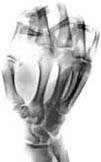
| Records | Reviews | Tracks | Concerts | Gallery |
Lifelike SleevenotesRalf Bei der KellenStaubgold, Oct 2003Staubgold Hans-Joachim Irmler owns a cordless phone. This implies that he does not reserve time to call people, but that he will call whoever he wants to talk to in whatever activity he's involved in at any moment. He will call you from the vaults of his wine-cellar, from his studio, from outside his house (raking the dead leaves) or from the kitchen. More often than not he will exclaim 'Listen to this!' in the middle of a conversation. And then he will dumbfound his partner by playing scraps of a new production, by shaking a tree or letting a cat miaow into the phone's receiver.
So it made absolute sense to me when he told me (on the phone, how else!) that he had produced a solo album in the form of a fictional aural biography. Originally, the tracks on this album were produced for the soundtrack of a tour through a museum, which portrayed the life of Roman soldiers at the turn of the millennium from BC to AD in Upper Swabia, where Irmler lives. After the music was completed and the tour installed (which took place about a year ago), Irmler put the tracks aside and concentrated on recording bands in his Klangbad studio and on compiling the remix album Freispiel and the collage-like album Patchwork. After some time, he came back to the tracks he recorded for the museum and compiled them into an order which to him made sense. Having done this, he found out that he had produced something which in its form very much resembles the path through a life, with its slow start, its acceleration, its times of struggle, possibly even of war, its slowing down and in the end... well, who knows? The sounds that are heard on this production he derived to a large extent from his collection of organs (which he, ever the mad scientist, never tires of modifying - his soldering iron is always on stand-by). He combined these with sounds from every-day life, so that - true to the old Dadaist spirit - he put art back into life (or vice versa). All of the sounds were recorded on analogue equipment and then distorted and alienated by Irmler - a procedure, which has always been central to his work: to take 'normal', ie. familiar sounds and transform them into new, unheard sounds. This technique he employed since the early days of Faust, where the band demanded in the contract with their record company that they were to have their own sound-engineer, who was to (and did) build them custom-made effect-boxes, so that they could link or distort their instruments and produce these unearthly sounds they wanted to explore and bring to the world like medieval explorers returning from a terra incognita and bringing with them never before seen plants and animals. To me, the music on this album sounds like the soundtrack to one of those early German silent films about the Nibelungenlied or the guerrilla battle of Arminius, chieftain of the Cherusci, against the Roman centurion Varus' army in the impenetrable Teutoburg Forrest. In so far, Lifelike could be seen as a minimalist version of Faust's monumental Nosferatu-Soundtrack. Giving the organ and the individual sounds more space, this is a much more intimate version, almost a chamber music suite. After a time, one realises that certain themes appear again and again throughout the album, often in combination with other parts from the work. But back to the cordless phone: Irmler also has the habit of calling people from his kitchen while preparing a meal. When I first heard this record, I was trimming Brussels Sprouts (and believe me, this album is an ideal soundtrack for that - as for many things in life). When I listen to it now, I find that the music is a bit like those small green vegetables: You strip one leaf away to find that it covered only part of the sprout. You scrutinise it and become aware of the intricate way in which these leaves are delicately fit into each other. In fact, I was so fascinated by these intricate patterns that I peeled away leaf after leaf. And I found that the pattern of the sprout's leafs mirrored the music's form. Thus my message is: Pay attention to the pattern. That's where the pleasure comes from. I wish your ears a healthy appetite. Ralf Bei der Kellen Ralf Bei der Kellen, "Lifelike Sleevenotes", Staubgold 2003ref: Staubgold |
|